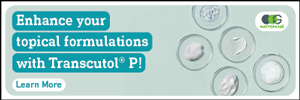Functional Excipients
Roquette Unlocks the Power of Flexibility With Launch of New Flex Softgel Capsule Shell System
Roquette recently announced the launch of its new LYCAGEL Flex hydroxypropyl pea starch premix for nutraceutical and pharmaceutical softgel capsules. Built on Roquette’s market-first LYCAGEL pea…
WHITEPAPER - Continuous Flow - An Emerging Alternative
In the whitepaper Continuous Flow: An Emerging Alternative, Curia experts discuss how continuous flow chemistry and processing offer an alternative pathway. The paper explores its….
SPECIAL FEATURE - Excipients: Advanced Biologics Require Innovative Excipient Science
Contributor Cindy H. Dubin speaks with several leading companies to discuss novel and functional excipients being developed, the role they will play in reformulations and new formulations, and their versatility in drug delivery.
SPECIAL FEATURE - Improving Bioavailability & Solubility: The Never-Ending Quest
Contributor Cindy H. Dubin speaks with several companies to review their innovative technologies in this annual report on bioavailability and solubility.
Evonik Partners With University of Mainz to Commercialize New Class of PEG Lipids for Nucleic Acid Delivery
Evonik and the University of Mainz have signed a license agreement to commercialize randomized polyethylene glycols (rPEGs), a new class of PEGs. Evonik intends to use….
Novo Holdings to Acquire Catalent
Catalent, Inc., a leader in enabling the development and supply of better treatments for patients worldwide, and Novo Holdings, a holding and investment company that is responsible for managing the assets and wealth of the Novo Nordisk Foundation, recently announced they….
SPECIAL ROUNDTABLE - Leadership Panel: 4 Trends That Will Have the Most Impact on Drug Development in 2024
Contributor Cindy H. Dubin asked some of today’s life science leaders what they expect will have the greatest impact on drug development in 2024 and beyond.
Colorcon Launches a New Titanium Dioxide-Free, High Opacity PVA-Based Coating for Pharmaceutical Tablets
Colorcon recently announced the launch of a new Opadry titanium dioxide (TiO2)-free film coating system for pharmaceutical tablets. Annabel Bordmann, Film Coatings General Manager, said…
Colorcon Unveils Corelease - A Unified Brand for Novel Controlled-Release Formulated Systems
Ready formulated systems approach simplifies the development and manufacturing for controlled release…..
2024 COMPANY PROFILES & CAPABILITIES
For each participating company, this section presents a detailed summary highlighting their core technologies, capabilities, technologies, and services.
CARBOMER CHEMISTRY - Breaking Ground in Controlled Release
Nicholas DiFranco, MEM, believes by working alone or alongside other well-established excipients for controlled release such as HPMC, the power of carbomer chemistry can help drug developers to overcome common challenges associated with controlled-release formulations without resorting to more complex techniques.
WHITEPAPER - Copolymer Microstructures: Connecting Monomer Sequence Distribution With Biomedical End-Application Performance
To gain insights into advanced copolymer characterization techniques and their impact on drug release in biomedical products, we invite you to explore the latest Corbion white paper…..
Roquette Completes Acquisition of Qualicaps & Reinforces Global Position in the Pharmaceutical Industry
This strategic investment creates a stronger leader, with an expanded global footprint, as well as an enriched offering of oral dosage solutions…..
Lubrizol Launches Carbopol Polymers for Nutraceuticals With New EU Food-Grade Approval
The Lubrizol Corporation recently announces the new EU food-grade approval for Carbopol Polymers. The approval in the EU will enable nutraceutical manufacturers the ability to…
WHITEPAPER - Monitoring Low Dose API Blend Uniformity With Parteck® M Mannitol Using Near-Infrared (NIR) Spectroscopy
Direct compression is often used for tablet manufacturing because it is the shortest, most effective, and least complex method. The physical properties of active pharmaceutical…
Ashland Showcases New Bioresorbable Polymers Technology Platform, Pharmaceutical Products & Solutions
Ashland is showcasing its recently launched bioresorbable polymers technology platform and two new life sciences products during upcoming tradeshows, including CPHI Barcelona, October 24-26, in…
WHITEPAPER - The Viscosity Reduction Platform: Viscosity-Reducing Excipients for Protein Formulation
This white paper evaluates the viscosity-reducing capacities of excipients and excipient combinations…..
SOLUBILIZING & STABILIZING TECHNOLOGY - CAPTISOL® - Part Perseverance & Part Serendipity
Vince Antle, PhD, James Pipkin, PhD, and Lian Rajewski, PhD, say with decades of experience, proven safety, and recent and forthcoming authorizations in several new routes of delivery, the Captisol Team is looking forward to the next 2 decades and more of new drug products, new applications, and continued improvement in the technology.
FUNCTIONAL EXCIPIENTS - Much More Than Filler: Solving the Challenge of Patient Non-Compliance
Carin Siow, PhD, explains how the progress to tackle the root causes of medication mis-use has been frustratingly slow and believes the pharma industry’s secret weapon in the fight against non-compliance are functional excipients.
WEBINAR - Beyond the Lab: Unleashing the Potential of In Silico Modeling in Drug Product Formulation
In this webinar you will learn how digital chemistry tools facilitate rapid screening of formulation parameters, aiding in the identification of optimal drug delivery systems, excipient selection, and dosage forms….
What are functional excipients?
The global pharmaceutical excipients market was valued at $7.7 billion in 2020 and is expected to reach $11.2 billion by 2026. Functional excipients are witnessing a strong demand as companies supply a wide range of functional excipients that help manufacturers produce cost-effective, high-quality, finished pharmaceutical product. Many industry experts point to a widening demand and use of organic pharmaceutical excipients. These organic excipients include oleochemicals, petrochemicals, proteins, carbohydrates, and others. Additionally, binders and functional excipients are witnessing a strong demand. Regarding delivery route, it is the topical segment that is witnessing fast growth in the global pharmaceutical excipients market, as topical drug delivery is witnessing a significantly stronger progression because of its ability to surpass the metabolism pathways of the stomach and liver.
However, the high cost associated with the drug development process will impede the growth rate of the pharmaceutical excipients market. Additionally, strict government regulations have hindered the pharmaceutical excipients market growth. Safety, quality concerns, and lack of awareness will further challenge the market in the forecast period mentioned above.
This is particularly true for novel excipients, which do have technical, therapeutic, and commercial benefits in oral drug delivery. Despite their formulation-enhancing benefits, novel excipients are sacrificed early in development because of a lack of precedence of use.
Without an independent pathway to allow new excipients or new uses for existing excipients into drug products, except when associated with a drug filing, there are limited tools available for pharmaceutical companies to formulate better performing, and in many cases, life-saving drugs. Meanwhile, drug manufacturers are reluctant to use new excipients and take on the additional layer of scrutiny from regulatory agencies to demonstrate full excipient characterization, safety, quality, function, and appropriateness of use.
Functional Excipients and the FDA
The Food & Drug Administration (FDA) has acknowledged that the lack of novel excipients is indeed a problem. In September 2021, the Agency announced the Novel Excipient Review Pilot Program, which will select and review four novel excipients in the next two years using a new pathway. This will allow manufacturers to obtain an FDA review prior to the use of the novel excipient in a drug formulation.
The FDA’s recent stance and acceptance that the novel excipients are critical in development of new drug candidates, the perceptions around the novel excipients are being changed as the Agency continues to embrace the facts that the pharma industry is in dire need of new excipients for bringing the innovative drugs to the market faster. This is the first time in history that the agency is opening doors for novel excipients to be freely evaluated and used in the innovative formulations for NCEs.
Note, though, that this is not an excipient approval process; the novel excipient would still be evaluated as part of the overall drug product approval. In the next 3 to 5 years, we can expect to see an acceleration in the examination of the composition and purity of excipients.





















